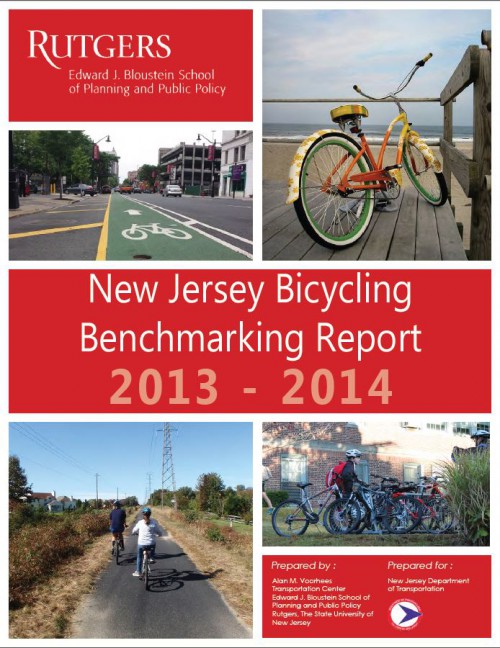In 2014, the Alan M. Voorhees Transportation Center undertook a study to benchmark the state of local bicycling investment in New Jersey municipalities for the years 2013-2014. The New Jersey Bicycling Benchmarking Report reviews the state of bicycle infrastructure, policies, programs, and safety in New Jersey. It relies primarily on 2013 and 2014 data provided by select municipalities through an extensive survey; secondary data from online resources was also used.
This report highlights many of the benefits that come from the implementation of modern bicycle infrastructure and policies, and will inspire municipalities across New Jersey to critically examine their support of bicycling in comparison with that of their peers.
As the first ever benchmarking report for New Jersey, significant effort was undertaken to bring transparency to information previously only available within municipal halls. Sixty municipalities were surveyed to catalog their level of spending on bicycling, their bicycle policies, and their implementation of programs such as Safe Routes to Schools and Complete Streets, among many other bicycle related metrics.
The report also highlights ten municipalities that are exemplary in their investment in a safe and convenient bicycling environment. The notable communities identified in the report are (in alphabetical order):
- Belmar, for having 9% of commuter trips done by bicycle, and having a police force fully trained to patrol on bicycle.
- Chatham Borough, for its investment in Safe Routes to Schools.
- Hoboken, for installing bicycle infrastructure on 37% of its streets, and deploying innovative bicycle facilities such as bicycle boxes to keep riders safe.
- Jersey City, for having the most bicycle route mileage of any surveyed municipality, and for joining the Citi Bike bicycle share system in the near future.
- Montclair Township, for its investment in Safe Routes to Schools, and for being the first municipality in New Jersey to pass a Complete Streets policy.
- Newark, for having the largest expenditure in bicycle infrastructure, and for using innovative bicycle facilities such as green bicycle lanes to keep riders safe.
- New Brunswick, for its progressive ordinances requiring motorists to pass bicycle riders safely, along with hosting the largest Ciclovia (open streets) in the state.
- Ocean City, as a model shore town for its investment in bicycle infrastructure, such as one of the only bicycle boulevards in New Jersey.
- Princeton, for its high bicycle mode share among residents, its extensive off-road bicycle infrastructure, and bicycle-friendly policies.
- West Windsor, for having the largest per capita investment in bicycle infrastructure, and showing how a suburban community can embrace bicycling.
More information on the policies and investments that make these municipalities notable is available in the report.
Drawing inspiration from the national Benchmarking Report created by the Alliance for Biking and Walking, this report highlights information that is valuable to municipalities, county governments, the New Jersey Department of Transportation, bicycle advocates, policy-makers, and New Jersey residents.
Findings of the report include:
- There is huge potential for improvement in New Jersey, even among the notable cities.
- The level of bicycling investment varies widely in New Jersey, but cities that have demonstrated commitment to bicycling are not limited to a specific geographic area or size.
- Few municipalities offer bicycle education or bicycling programs for residents.
- Most municipalities did not spend money on bicycling in 2013.
- Innovative bicycle infrastructure, such as green bicycle lanes, advanced stop lines, and protected bicycle lanes are still rare in New Jersey, and many municipalities have no dedicated bicycle infrastructure at all.
- Shore communities have the highest bicycle mode share, and also have among the fewest numbers of bicycle-automobile collisions
Please read the full report for additional information and statistics.
Read full report: New Jersey Bicycling Benchmarking Report (2015)

